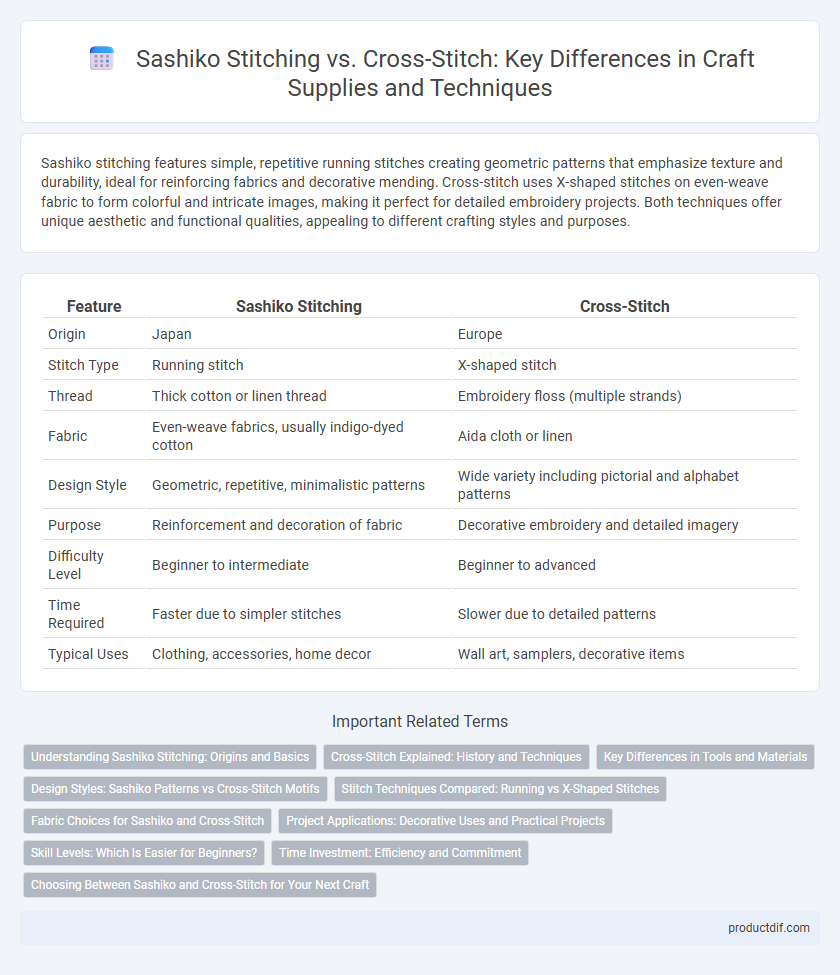Sashiko stitching features simple, repetitive running stitches creating geometric patterns that emphasize texture and durability, ideal for reinforcing fabrics and decorative mending. Cross-stitch uses X-shaped stitches on even-weave fabric to form colorful and intricate images, making it perfect for detailed embroidery projects. Both techniques offer unique aesthetic and functional qualities, appealing to different crafting styles and purposes.
Table of Comparison
| Feature | Sashiko Stitching | Cross-Stitch |
|---|---|---|
| Origin | Japan | Europe |
| Stitch Type | Running stitch | X-shaped stitch |
| Thread | Thick cotton or linen thread | Embroidery floss (multiple strands) |
| Fabric | Even-weave fabrics, usually indigo-dyed cotton | Aida cloth or linen |
| Design Style | Geometric, repetitive, minimalistic patterns | Wide variety including pictorial and alphabet patterns |
| Purpose | Reinforcement and decoration of fabric | Decorative embroidery and detailed imagery |
| Difficulty Level | Beginner to intermediate | Beginner to advanced |
| Time Required | Faster due to simpler stitches | Slower due to detailed patterns |
| Typical Uses | Clothing, accessories, home decor | Wall art, samplers, decorative items |
Understanding Sashiko Stitching: Origins and Basics
Sashiko stitching, a traditional Japanese embroidery technique, originated as a practical method for reinforcing fabric with simple running stitches arranged in geometric patterns. Unlike cross-stitch, which forms X-shaped stitches on fabric grids, Sashiko uses straight, evenly spaced stitches typically in white thread on indigo cloth to create textured designs. Understanding Sashiko's origins in mending and its emphasis on minimalist patterns highlights its cultural significance and functional artistry in craft supplies.
Cross-Stitch Explained: History and Techniques
Cross-stitch, originating from ancient Egypt and popularized in Europe during the Middle Ages, is a counted-thread embroidery technique characterized by X-shaped stitches on fabric grids. This method allows for precise, detailed patterns and is commonly stitched on evenweave fabrics like Aida cloth, making it accessible for both beginners and advanced crafters. Unlike Sashiko, which emphasizes functional reinforcement and simple geometric patterns, cross-stitch focuses on decorative designs using vibrant threads to create intricate images and motifs.
Key Differences in Tools and Materials
Sashiko stitching utilizes a thicker, stronger thread called sashiko thread and a unique needle designed for running stitches through layers of fabric, typically using indigo-dyed cotton cloth. Cross-stitch requires finer embroidery floss, often made of stranded cotton, along with a tapestry needle with a blunt tip to navigate evenly woven Aida or linen fabric. While sashiko emphasizes durability and geometric patterns for reinforcement, cross-stitch focuses on detailed, colorful designs suitable for decorative art.
Design Styles: Sashiko Patterns vs Cross-Stitch Motifs
Sashiko stitching features geometric and repetitive patterns inspired by traditional Japanese aesthetics, often emphasizing simplicity and uniformity in white thread on indigo fabric. Cross-stitch motifs showcase a wider variety of colorful images, including floral designs, animals, and intricate scenes, created through a grid-based stitching technique. The distinct design styles highlight Sashiko's focus on texture and subtlety, while cross-stitch offers vibrant and detailed visual storytelling.
Stitch Techniques Compared: Running vs X-Shaped Stitches
Sashiko stitching utilizes running stitches that create linear, repetitive patterns for texture and subtle geometric designs, contrasting with cross-stitch's X-shaped stitches that form dense, pixelated images on fabric. The running stitches in Sashiko emphasize simplicity and durability, making it ideal for reinforcing and decorating textiles, while the cross-stitch technique relies on crossing threads to build complex and colorful motifs. Craft supply enthusiasts often choose between these techniques based on desired visual effects, fabric types, and project goals.
Fabric Choices for Sashiko and Cross-Stitch
Sashiko stitching traditionally uses tightly woven, durable fabrics like indigo-dyed cotton or linen, which support the running stitch and emphasize texture. Cross-stitch typically requires evenweave fabrics such as Aida or linen, featuring an open grid that facilitates precise counting and geometric patterns. Fabric selection significantly impacts the stitch definition and overall appearance in both Sashiko and Cross-stitch projects.
Project Applications: Decorative Uses and Practical Projects
Sashiko stitching features geometric patterns ideal for reinforcing fabric and adding subtle decorative texture, making it perfect for mending denim, creating quilted home decor, and embellishing clothing with minimalist aesthetic. Cross-stitch offers colorful, intricate designs suited for detailed artwork on samplers, framed pieces, and personalized gifts, often used in decorative wall hangings, cushion covers, and embroidery hoops. Both techniques excel in craft projects, with sashiko emphasizing durability and understated beauty, while cross-stitch highlights vibrant, pictorial embellishments.
Skill Levels: Which Is Easier for Beginners?
Sashiko stitching features simple running stitches with repetitive geometric patterns, making it easier for beginners to master compared to the more intricate X-shaped stitches of cross-stitch that require counting precise grid points. Cross-stitch typically demands higher precision and familiarity with embroidery hoops and fabric grids, which can challenge novices. Beginners often find sashiko more accessible due to its flowing designs and straightforward techniques, easing the learning curve for stitching projects.
Time Investment: Efficiency and Commitment
Sashiko stitching requires less time investment per pattern due to its repetitive running stitches, making it more efficient for completing large designs quickly. Cross-stitch demands higher time commitment as each stitch forms a precise X, requiring detailed attention and slower progress. Choosing between Sashiko and Cross-stitch depends on balancing efficiency with the desired intricacy and patience for craft projects.
Choosing Between Sashiko and Cross-Stitch for Your Next Craft
When choosing between Sashiko and Cross-Stitch for your next craft project, consider that Sashiko features simple, geometric running stitches ideal for reinforcing fabric and creating minimalist patterns, while Cross-Stitch uses X-shaped stitches best suited for detailed, colorful embroidery designs. Sashiko typically employs thicker thread and indigo-dyed fabric, offering durability and a traditional Japanese aesthetic, whereas Cross-Stitch allows for more intricate images with a variety of thread colors and fabric types. Assess the desired design complexity, fabric texture, and cultural style to select the technique that enhances your craft's visual impact and functional purpose.
Sashiko stitching vs Cross-stitch Infographic

 productdif.com
productdif.com